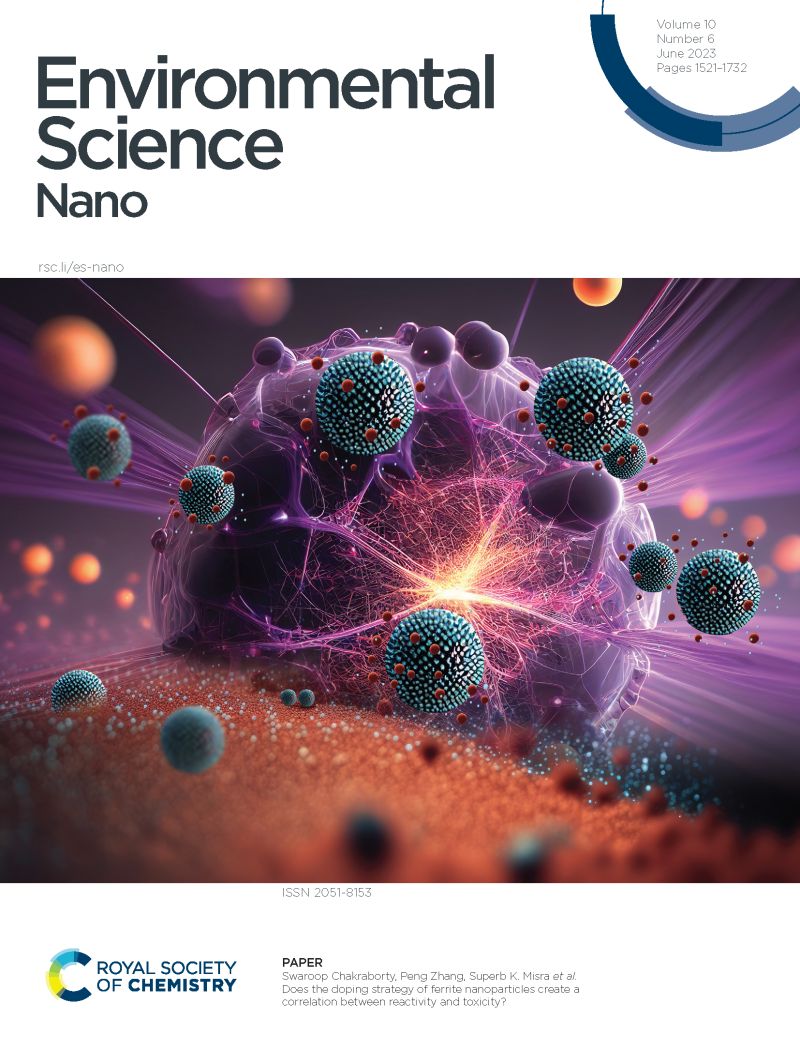Exploring the impact of nanoplastics on human hepatic cells: dynamics of internalization and harmful effects in HuH-7 cells
IF 5.1
2区 环境科学与生态学
Q1 CHEMISTRY, MULTIDISCIPLINARY
引用次数: 0
Abstract
The increasing prevalence of micro- and nanoplastics (MNPLs) in the environment necessitates a detailed examination of their potential health impacts and the factors that influence these responses. Since internalization is a prerequisite for inducing adverse effects, we investigated the roles of surface modifications and polymer composition in human liver cells (HUH-7). Our study compared the internalization and effects of a pristine polystyrene nanoplastic (PS50-NPLs), two carboxylated polystyrenes of different sizes (cPS50-NPLs and cPS100-NPLs), and two environmentally relevant nanoplastics derived from polyethylene terephthalate water bottles (PET-NPLs) and polylactic acid pellets (PLA-NPLs). Significant variations in cell internalization were observed, with cPS50-NPLs and PET-NPLs showing the highest levels, and PS50-NPLs the lowest. Interestingly, internalization alone did not correlate directly with the induced effects; only PET-NPLs and PLA-NPLs induced reactive oxygen species (ROS), genotoxicity, and increased cytokine release. These results suggest that while internalization is essential in assessing MNPL toxicity, harmful effects also depend on other particle characteristics. The notable impact of the true-to-life PET-NPLs and PLA-NPLs underscores the importance of using environmentally representative MNPLs to better assess the health risks associated with environmental MNPL exposure.探索纳米塑料对人肝细胞的影响:HuH-7细胞内化和有害影响的动态
随着环境中微塑料和纳米塑料(MNPLs)的日益普遍,有必要对其潜在的健康影响和影响这些反应的因素进行详细研究。由于内化是诱发不良反应的先决条件,我们研究了表面修饰和聚合物组成在人肝细胞中的作用(HUH-7)。我们的研究比较了一种原始聚苯乙烯纳米塑料(PS50-NPLs)、两种不同尺寸的羧化聚苯乙烯(cPS50-NPLs和cPS100-NPLs)以及两种由聚对苯二甲酸乙二醇酯水瓶(PET-NPLs)和聚乳酸颗粒(PLA-NPLs)制成的环保纳米塑料的内化和效果。观察到细胞内化的显著差异,cPS50-NPLs和PET-NPLs水平最高,PS50-NPLs最低。有趣的是,内化本身并不直接与诱导效应相关;只有PET-NPLs和PLA-NPLs诱导活性氧(ROS)、遗传毒性和细胞因子释放增加。这些结果表明,虽然内化是评估MNPL毒性的必要条件,但有害影响还取决于其他颗粒特征。真实的pet - npl和pla - npl的显著影响强调了使用具有环境代表性的MNPL来更好地评估与环境MNPL暴露相关的健康风险的重要性。
本文章由计算机程序翻译,如有差异,请以英文原文为准。
求助全文
约1分钟内获得全文
求助全文
来源期刊

Environmental Science: Nano
CHEMISTRY, MULTIDISCIPLINARY-ENVIRONMENTAL SCIENCES
CiteScore
12.20
自引率
5.50%
发文量
290
审稿时长
2.1 months
期刊介绍:
Environmental Science: Nano serves as a comprehensive and high-impact peer-reviewed source of information on the design and demonstration of engineered nanomaterials for environment-based applications. It also covers the interactions between engineered, natural, and incidental nanomaterials with biological and environmental systems. This scope includes, but is not limited to, the following topic areas:
Novel nanomaterial-based applications for water, air, soil, food, and energy sustainability
Nanomaterial interactions with biological systems and nanotoxicology
Environmental fate, reactivity, and transformations of nanoscale materials
Nanoscale processes in the environment
Sustainable nanotechnology including rational nanomaterial design, life cycle assessment, risk/benefit analysis
 求助内容:
求助内容: 应助结果提醒方式:
应助结果提醒方式:


